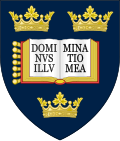


The vice-chancellor of the University of Oxford is the chief executive and leader of the University of Oxford. The following people have been vice-chancellors of the University of Oxford (formally known as The Right Worshipful the Vice-Chancellor): [1] [2]
